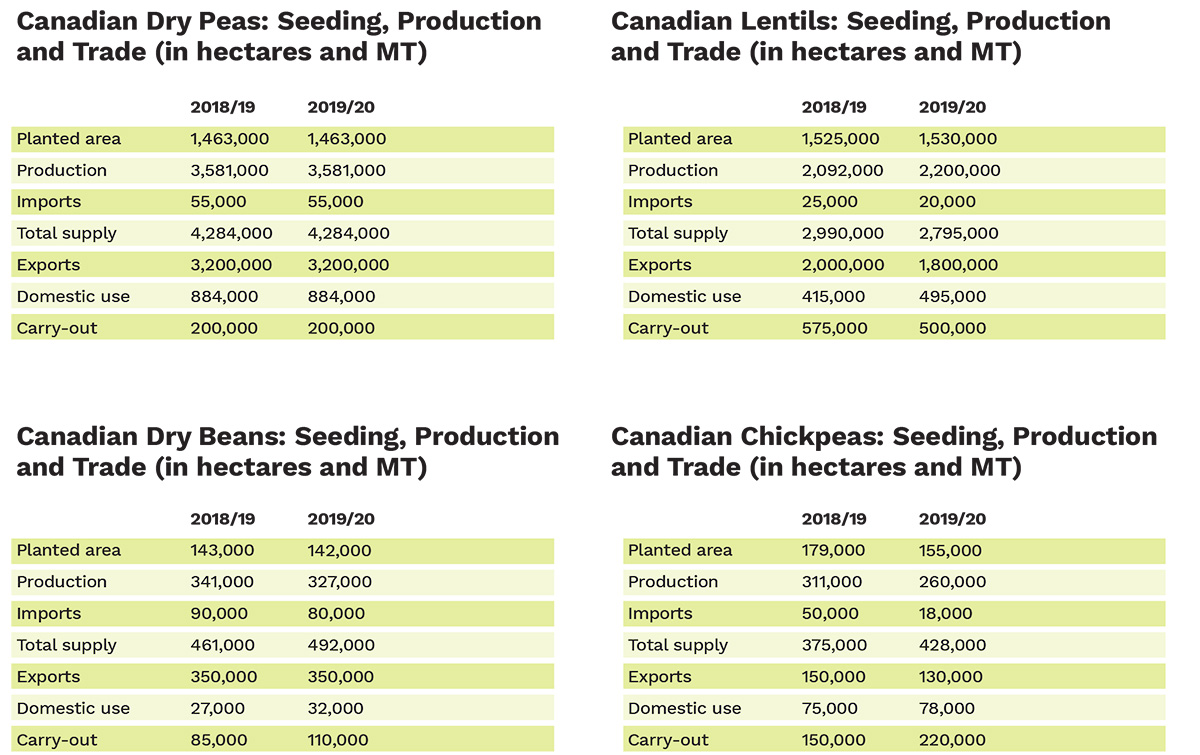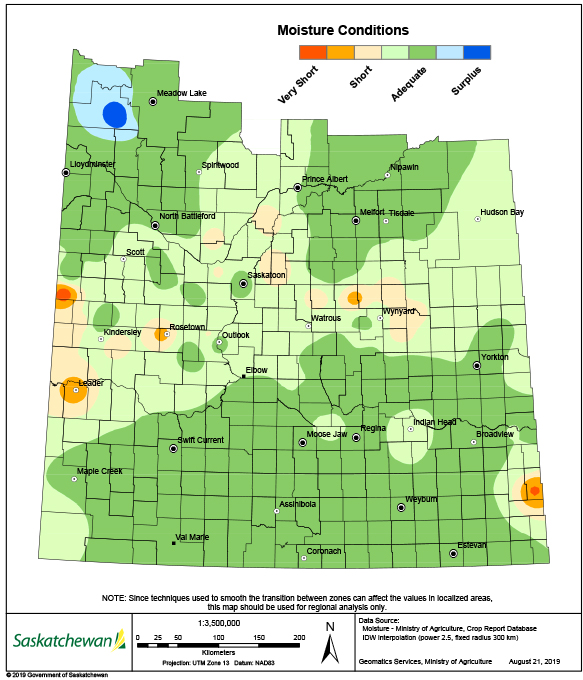August 27, 2019
The pea harvest is underway in Canada’s Western Prairies. August weather conditions have been generally wet and cool.

In its August 21 Outlook for Principal Field Crops, Agriculture and Agri-Food Canada estimates the area seeded to pulses and special crops in 2019/20 at 3.8 million hectares, up from 3.6 million hectares the previous cycle.
Canada’s pea area is estimated at 1.75 million hectares and production is forecast at 4.3 million MT, up 20% over the previous harvest. It is important to note, however, that at the Canada Pulse and Special Crops Convention held in Montreal last week, Left Field Commodity Research reported that Canada's 2018/19 dry pea production was underestimated by 250,000 MT. For the 2019/20 crop, half of the production is expected to come from Saskatchewan, 45% from Alberta, 3% from Manitoba and 2% from other parts of the country. In the U.S., production is projected at 800,000 MT.
Canada’s lentil area is estimated at 1.5 million hectares, about the same as last year, but with fewer green lentil hectares and more red lentil hectares. Production is forecast to increase 5% to 2.2 million MT, with Saskatchewan contributing 89% of that volume and Alberta the remainder. The overall supply is forecast at nearly 2.8 million, lower than last year’s nearly 3 million due to lower carry-in. Canadian pea exports are forecast at 1.8 million MT. At the Canada Pulses and Special Crops Convention, however, Mercantile Consulting projected slightly higher pea exports (1.9 million MT). In the U.S., production is projected to drop sharply to less than 300,000 MT.
The area seeded to dry beans in Canada is estimated at 142,000 hectares, about the same as last year. Because of a lower yield expectation, however, production is forecast at 327,000 MT, down from last year’s 341,000 MT. Ontario is expected to contribute 36% of production, Manitoba 43%, and Alberta 16%, with the balance coming from other parts of Canada. U.S. dry bean production is estimated at 1.1 million MT, about the same as last year.
Canada’s chickpea plantings are estimated at 155,000 hectares, down from 179,000 hectares last year. Production is forecast at 260,000 MT, down from 311,000 MT on reduced plantings and lower yields. Even so, due to burdensome carry-in, the overall supply is projected to be higher in 2019/20, at 428,000 MT compared to 375,000 MT last marketing year. At the Canada Pulses and Special Crops Convention, Left Field Commodity Research estimated Canada's total chickpea supply at an even higher level, pegging it slightly above 450,000 MT. In the U.S., production is projected to drop by 40% to 360,000 MT.
Below we take a closer look at the major pulse-growing provinces of Alberta, Manitoba and Saskatchewan. The information that follows is drawn from provincial crop reports.

Source: Agriculture and Agri-Food Canada, Outlook for Principal Field Crops, August 21, 2019.
As of August 13, the pea, lentil and chickpea crops rated 62%, 30% and 26% good to excellent, respectively. Dry pea crop conditions varied widely from region to region. In northeast Alberta, the crop rated nearly 80% good to excellent, while in the northwest it rated 38% good to excellent. The lentil crop rated nearly 40% good to excellent in the central part of the province, compared to 28% in the south. The chickpea crop was more consistent, rating 25% and 26% good to excellent in the south and central regions respectively, where chickpeas are grown.
In the case of peas, the crop is currently being desiccated in the southern region. The region received cool weather in August, which delayed the harvesting of crops. Additionally, hailstorms in early August caused some damage. In the central region, the pea crop is facing heightened disease pressure due to excessive moisture. The same is true in the northwest region, where crops are experiencing root rot due to extremely wet conditions. Crops in the northwest region were also hit by hail in early August.
As of August 20, Manitoba pulse growers harvested 63% of their field peas, behind last year’s pace of 98%. In the southwest region of the province, rain and cool temperatures have slowed harvest. Half the pea crop has come off the fields and the harvest is expected to wrap up before the end of August. Yields have averaged 50 to 60 bushels/acre and the quality has been good. In the northwest region, moisture is lacking. Faba bean crop is maturing. Pea yields are expected to be below average to average. In the central region, the pea harvest is well underway. The quality is good and yields have varied from 40 to 65 bushels/acre. The dry bean crop in this region has set pods and is yellowing.
Growers in Saskatchewan are just starting to harvest their pulse crops. As of August 12, 3% of the peas and 1% of lentils have been combined. Harvest has been somewhat delayed by rains. Topsoil moisture is rated 81% adequate to surplus. In the southeast and southwest regions, pea harvest progress is at 8% and 5% respectively, and the lentil harvest is at 3% and 2%, respectively. In the east-central region of the province, pulse crops are being desiccated. This region has received some rain, which could affect the quality of the pulse crop. In the west-central region, the situation is similar, with pulse crops being desiccated and reports of rain. In the northeast region, peas are being desiccated. In the northwest region, pulse crops are starting to mature.

Source: Government of Saskatchewan, Crop Report for week ending August 19.
Disclaimer: The opinions or views expressed in this publication are those of the authors or quoted persons. They do not purport to reflect the opinions or views of the Global Pulse Confederation or its members.